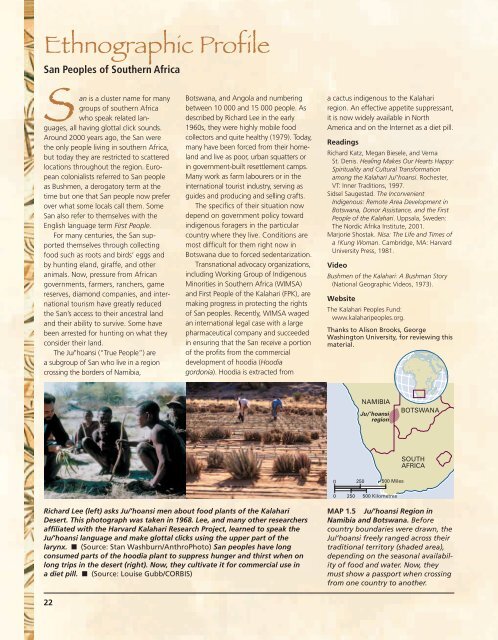PART Introduction to Cultural Anthropology - Pearson Canada
PART Introduction to Cultural Anthropology - Pearson Canada
PART Introduction to Cultural Anthropology - Pearson Canada
Create successful ePaper yourself
Turn your PDF publications into a flip-book with our unique Google optimized e-Paper software.
Ethnographic Profile<br />
San Peoples of Southern Africa<br />
San is a cluster name for many<br />
groups of southern Africa<br />
who speak related languages,<br />
all having glottal click sounds.<br />
Around 2000 years ago, the San were<br />
the only people living in southern Africa,<br />
but <strong>to</strong>day they are restricted <strong>to</strong> scattered<br />
locations throughout the region. European<br />
colonialists referred <strong>to</strong> San people<br />
as Bushmen, a deroga<strong>to</strong>ry term at the<br />
time but one that San people now prefer<br />
over what some locals call them. Some<br />
San also refer <strong>to</strong> themselves with the<br />
English language term First People.<br />
For many centuries, the San supported<br />
themselves through collecting<br />
food such as roots and birds’ eggs and<br />
by hunting eland, giraffe, and other<br />
animals. Now, pressure from African<br />
governments, farmers, ranchers, game<br />
reserves, diamond companies, and international<br />
<strong>to</strong>urism have greatly reduced<br />
the San’s access <strong>to</strong> their ancestral land<br />
and their ability <strong>to</strong> survive. Some have<br />
been arrested for hunting on what they<br />
consider their land.<br />
The Ju/’hoansi (“True People”) are<br />
a subgroup of San who live in a region<br />
crossing the borders of Namibia,<br />
Botswana, and Angola and numbering<br />
between 10 000 and 15 000 people. As<br />
described by Richard Lee in the early<br />
1960s, they were highly mobile food<br />
collec<strong>to</strong>rs and quite healthy (1979). Today,<br />
many have been forced from their homeland<br />
and live as poor, urban squatters or<br />
in government-built resettlement camps.<br />
Many work as farm labourers or in the<br />
international <strong>to</strong>urist industry, serving as<br />
guides and producing and selling crafts.<br />
The specifics of their situation now<br />
depend on government policy <strong>to</strong>ward<br />
indigenous foragers in the particular<br />
country where they live. Conditions are<br />
most difficult for them right now in<br />
Botswana due <strong>to</strong> forced sedentarization.<br />
Transnational advocacy organizations,<br />
including Working Group of Indigenous<br />
Minorities in Southern Africa (WIMSA)<br />
and First People of the Kalahari (FPK), are<br />
making progress in protecting the rights<br />
of San peoples. Recently, WIMSA waged<br />
an international legal case with a large<br />
pharmaceutical company and succeeded<br />
in ensuring that the San receive a portion<br />
of the profits from the commercial<br />
development of hoodia (Hoodia<br />
gordonia). Hoodia is extracted from<br />
a cactus indigenous <strong>to</strong> the Kalahari<br />
region. An effective appetite suppressant,<br />
it is now widely available in North<br />
America and on the Internet as a diet pill.<br />
Readings<br />
Richard Katz, Megan Biesele, and Verna<br />
St. Denis. Healing Makes Our Hearts Happy:<br />
Spirituality and <strong>Cultural</strong> Transformation<br />
among the Kalahari Ju/’hoansi. Rochester,<br />
VT: Inner Traditions, 1997.<br />
Sidsel Saugestad. The Inconvenient<br />
Indigenous: Remote Area Development in<br />
Botswana, Donor Assistance, and the First<br />
People of the Kalahari. Uppsala, Sweden:<br />
The Nordic Afrika Institute, 2001.<br />
Marjorie Shostak. Nisa: The Life and Times of<br />
a !Kung Woman. Cambridge, MA: Harvard<br />
University Press, 1981.<br />
Video<br />
Bushmen of the Kalahari: A Bushman S<strong>to</strong>ry<br />
(National Geographic Videos, 1973).<br />
Website<br />
The Kalahari Peoples Fund:<br />
www.kalaharipeoples.org.<br />
Thanks <strong>to</strong> Alison Brooks, George<br />
Washing<strong>to</strong>n University, for reviewing this<br />
material.<br />
NAMIBIA<br />
Ju/’hoansi<br />
region<br />
BOTSWANA<br />
SOUTH<br />
AFRICA<br />
0 250 500 Miles<br />
0 250 500 Kilometres<br />
Richard Lee (left) asks Ju/’hoansi men about food plants of the Kalahari<br />
Desert. This pho<strong>to</strong>graph was taken in 1968. Lee, and many other researchers<br />
affiliated with the Harvard Kalahari Research Project, learned <strong>to</strong> speak the<br />
Ju/’hoansi language and make glottal clicks using the upper part of the<br />
larynx. ■ (Source: Stan Washburn/AnthroPho<strong>to</strong>) San peoples have long<br />
consumed parts of the hoodia plant <strong>to</strong> suppress hunger and thirst when on<br />
long trips in the desert (right). Now, they cultivate it for commercial use in<br />
a diet pill. ■ (Source: Louise Gubb/CORBIS)<br />
MAP 1.5 Ju/’hoansi Region in<br />
Namibia and Botswana. Before<br />
country boundaries were drawn, the<br />
Ju/’hoansi freely ranged across their<br />
traditional terri<strong>to</strong>ry (shaded area),<br />
depending on the seasonal availability<br />
of food and water. Now, they<br />
must show a passport when crossing<br />
from one country <strong>to</strong> another.<br />
22
















